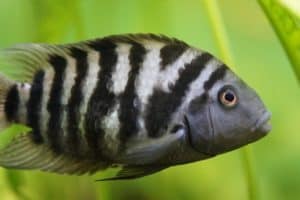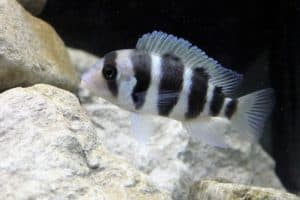Cichlids are a family of fish comprising of at least 1700 varieties and found in freshwater environments throughout Africa, Asia, and South America. Like angelfish and discus fish, cichlid fish are a favourite in the aquarium hobby. Not all species, however, can thrive in a planted tank. Right now, you may be curious as to which ones can be kept in a ‘green’ or aquascape aquarium?
The best species of cichlid fish for a planted tank are the smaller ‘dwarfs’ from South America like apistogramma and mikrogeophagus cichlids. Larger cichlids found in the lakes of Malawi or Tanganyika in Africa, are NOT suitable for a planted tank as they will devour and/or uproot the foliage. Some species like discus or angelfish, however, make great ‘centre pieces’ for planted tanks.
Now that you know smaller cichlids do well in a planted tank, let us take a closer look at this further and in more detail below. We will discuss which plants work well in a cichlid tank as well as whether (or not) African cichlids can be kept in an aquascape aquarium. We will also explore the various types of plants found in many aquascape tanks and how the different cichlid fish species will often respond to them.
So, if you are ready to learn more, then please read onward…
Can You have Cichlids in a Planted Tank?
You can have cichlids in a planted tank, provided they are the smaller species from South America. These include the following:
Dwarf cichlids
For a ‘green’ aquarium with a heavy focus on aquascaping, dwarf cichlids are a great choice. Be sure the water parameters in the tank support both the plant life as well as the fish. For dwarf cichlids (and most aquatic plants as well), the water should be on the softer side, which is slightly acidic – a pH level around 7 or 7.5.
The temperature should also be a bit warmer – somewhere between 22 and 27 degrees Celsius (or 72 to 86 degrees Fahrenheit) with an alkalinity level around 5 dKH. It is important to note that most dwarf cichlids sold today are highly adaptable and can thrive in a wider range of water parameters, which is due in part to captive breeding.
Since males of this species are often territorial in nature, a planted tank is ideal since it provides many places to hide and/or spawn. It is recommended that you keep dwarf cichlids in pairs or in an aquarium with a male-to-female ratio of 1:3. The reason being that too many males and not enough females can increase tension and aggression in fish.
The two types of dwarf cichlids that are best suited for a planted tank include:
Apistogramma cichlids
These highly colourful and active fish are popular with many aquarium hobbyists. The cockatoo dwarf cichlid, for example, measures less than 10 cm in length and is ideal for an aquascape tank. Since they are substrate spawners, they require a sandy bottom and lots of foliage with many hiding places.
Consider adding a few natural decorations like stones or driftwood to the aquarium and keep them in pairs, if possible. Since apistogrammas are territorial in nature (even females can become aggressive during the breeding season), the tank should be quite large – at least 20 gallons or bigger!
Mikrogeophagus cichlids
These fish are brightly coloured and lively – think rainbow and ram cichlids! The butterfly cichlid, for example, attracts attention with its beautiful patterns and active nature. Since this species stays small (around 6 cm long), it is perfect for a planted tank.
Flat stones or leaves are required in the aquarium as mikrogeophagus are open breeders that spawn in shallow craters in the soil. They will dig these holes before beginning the mating ritual and should be kept in pairs, if possible, as both males and females participate equally in parenting their offspring.

Can African Cichlids be Kept in a Planted Tank?
Large cichlids like those from Malawi or Tanganyika in Africa are usually not suitable for a planted tank environment. As plants are usually sparse in their natural habitats, these cichlid species will either devour them or uproot them. Only the very hard-leaved plants like anubias could likely survive.
What Live Plants are Good for Cichlids?
The best types of live plants for a cichlid tank include:
Anubias
This plant has hard, pear-shaped leaves which are unappealing to hungry cichlids. Their roots holdfast and can be cultivated on driftwood or stones. This prevents them from being disturbed when cichlid fish forage or nest along the substrate. It also comes in a variety of sizes and colors, making it the perfect choice for an aquascape aquarium!
Java Fern
This plant is like anubias and clings well to stones and driftwood. It has hardy, robust leaves and is relatively easy to care for. Adult java fern will thrive in a planted tank with cichlids. Young plants, on the other hand, have softer shoot tips which more likely to be eaten. It varies in leaf size and shape and is one of the most widely used plants in aquascape aquariums.
Vallisneria
This plant is fast-growing and cichlid-proof! It is typically used as a background plant in an aquascape aquarium. It too has robust leaves that are hard, yet not as hard as anubias. Often referred to as ‘tape grass’ it is a style of submerged plant that spreads by runners, which can sometimes form what looks like tall, underwater meadows in the tank.
Will Cichlids Eat Live Plants?
Most large cichlids from Africa tend to not eat live plants. However, they will uproot them in an effort to ‘rearrange’ the tank. Some of the smaller cichlid species from South America may nibble on the soft tips of the plants but in most cases, they steer clear of them.

Will Cichlids Eat Anubias?
Cichlid fish will probably not eat anubias plants, as they have ‘hard’ leaves which are thick and difficult to penetrate. This in, in fact, one plant that almost all fish avoid ingesting. Even if some fish choose to nibble on it, it is usually strong enough to withstand it.
Do Cichlids Eat Moss?
While some cichlids may eat aquarium plants, moss is something they usually avoid ingesting. They may graze slightly upon moss-covered driftwood or rocks, but they likely will not devour it completely. Other plants like java fern tend to be more to their liking.
Do Peacock Cichlids Eat Plants?
Peacock cichlids are a type of African cichlid and as such, can have a voracious appetite for live plants. In most cases, these fish require specific water parameters that do not support aquatic plant life. They prefer a pH of 8 to 8.5 which contains a higher concentration of minerals that is often harmful to most aquarium plants.
Do African Cichlids Eat Duckweed?
African cichlids like peacocks will eat duckweed. In fact, they will devour it enthusiastically! In most cases, this plant can reproduce fast enough to re-establish itself and thrive in a planted tank with cichlids. A balance is often struck between the fish and the plant, preventing the duckweed from overcrowding the aquarium while still growing despite the constant grazing by the cichlid.
Conclusion
To conclude, the best species of cichlid fish for a ‘green’ aquarium are those from South America like apistogramma and mikrogeophagus cichlids. These small dwarf cichlids thrive in a planted tank environment as they are territorial in nature and plenty of hiding places to establish their own area.
Larger African cichlids like those from the lakes of Malawi or Tanganyika Africa, however, are not well-suited for a planted tank as they tend to devour and/or uproot the foliage. On the other hand, some species like discus or angelfish can make great ‘centre pieces’ for an aquascape aquarium.
Hopefully, you have found this article to be both interesting and informative. Thanks for reading and good luck with your planted cichlid tank!
Related Aquariums at Home Articles
Can Cichlids Live with Other Tropical Fish?
What Cichlids Can Live Together?
Are Discus Hard to Care For? [What You Must know]
20 Best Freshwater Fish for a Planted Tank
Should German Blue Rams be Kept in Pairs?
Jack Dempsey Fish Care Guide (Species Profile, Aquarium Setup & Tankmates)






